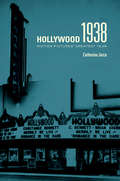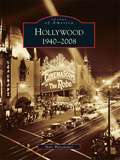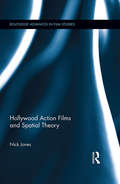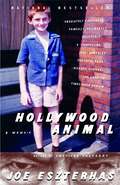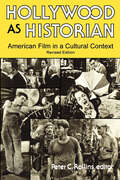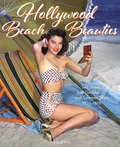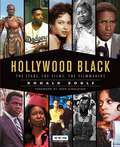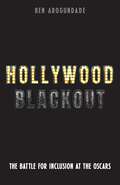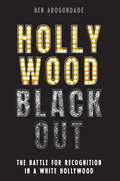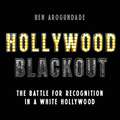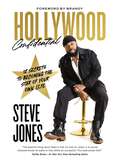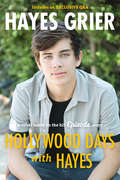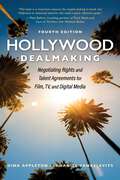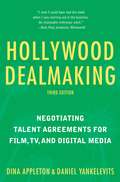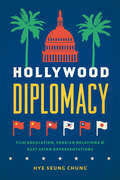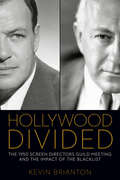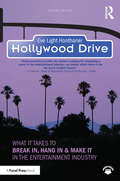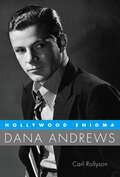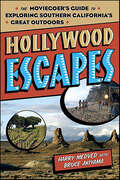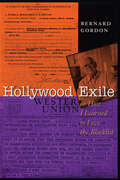- Table View
- List View
Hollywood 1938
by Catherine JurcaIn Hollywood 1938, Catherine Jurca brings to light a tumultuous year of crisis that has been neglected in histories of the studio era. With attendance in decline, negative publicity about stars that were "poison at the box office," and a spate of bad films, industry executives decided that the public was fed up with the movies. Jurca describes their desperate attempt to win back audiences by launching Motion Pictures' Greatest Year, a massive, and unsuccessful, public relations campaign conducted in theaters and newspapers across North America. Drawing on the records of studio personnel, independent exhibitors, moviegoers, and the motion pictures themselves, she analyzes what was wrong--and right--with Hollywood at the end of a heralded decade, and how the industry's troubles changed the making and marketing of films in 1938 and beyond.
Hollywood 1940-2008
by Marc WanamakerSince World War II, Hollywood has fought and won that same war many times, won the West even more often--plus got the girl--and laughed like crazy, too. The postwar era in the dream factory was a prosperous time of expansion and wealth through the 1970s, decline in the 1980s, and rebirth in the new century. Vintage photographs from the rare collections of Hollywood Heritage and Bison Archives depict the municipal, business, residential, and entertainment industry growth in Hollywood proper, from 1940 until the beginning of the 21st century. This companion volume to Arcadia Publishing's Early Hollywood completes the pictorial saga of the world's most renowned storytelling capital. These images depict the rise of the television industry, changes along Hollywood Boulevard, and movers and shakers whose visions and influence have made Hollywood the entertainment industry's Mecca.
Hollywood Action Films and Spatial Theory (Routledge Advances in Film Studies)
by Nick JonesThis book applies the discourse of the so-called ‘spatial turn’ to popular contemporary cinema, in particular the action sequences of twenty-first century Hollywood productions. Tackling a variety of spatial imaginations (contemporary iconic architecture; globalisation and non-places; phenomenological knowledge of place; consumerist spaces of commodity purchase; cyberspace), the diverse case studies not only detail the range of ways in which action sequences represent the challenge of surviving and acting in contemporary space, but also reveal the consistent qualities of spatial appropriation and spatial manipulation that define the form. Jones argues that action sequences dramatise the restrictions and possibilities of space, offering examples of radical spatial praxis through their depictions of spatial engagement, struggle and eventual transcendence.
Hollywood Animal: A Memoir
by Joe EszterhasHe spent his earliest years in post WWII-refugee camps. He came to America and grew up in Cleveland--stealing cars, rolling drunks, battling priests, nearly going to jail. He became the screenwriter of the worldwide hits Basic Instinct, Jagged Edge, and Flashdance. He also wrote the legendary disasters Showgirls and Jade. The rebellion never ended, even as his films went on to gross more than a billion dollars at the box office and he became the most famous--or infamous--screenwriter in Hollywood. Joe Eszterhas is a complex and paradoxical figure: part outlaw and outsider combined with equal parts romantic and moralist. More than one person has called him "the devil. " He has been referred to as "the most reviled man in America. " But Time asked, "If Shakespeare were alive today, would his name be Joe Eszterhas?" and he was the first screenwriter picked as one of the movie industry's 100 Most Powerful People. Although he is often accused of sexism and misogyny, his wife is his best friend and equal partner. Considered an apostle of sex and violence, he is a churchgoer who believes in the power of prayer. For many years the ultimate symbol of Hollywood excess, he has moved his family to Ohio and immersed himself in the midwestern lifestyle he so values. Controversial, fearless, extremely talented, and totally unpredictable, the author of the best-selling American Rhapsody and National Book Award nominee Charlie Simpson's Apocalypse has surprised us yet again: he has written a memoir like no other. On one level, Hollywood Animal is a shocking and often devastating look inside the movie business. It intimately explores the concept of fame and gives us a never-before-seen look at the famous. Eszterhas reveals the fights, the deals, the extortions, the backstabbing, and the sex, drugs, and rock'n'roll world that is Hollywood. But there are many more levels to this extraordinary work. It is the story of a street kid who survives a life filled with obstacles and pain . . . a chronicle of a love affair that is sensual, glorious, and unending . . . an excruciatingly detailed look at a man facing down the greatest enemy he's ever fought: the cancer inside him . . . and perhaps most important, Hollywood Animal is the heartbreaking story of a father and son that defines the concepts of love and betrayal. This is a book that will shock you and make you laugh, anger you and move you to tears. It is pure Joe Eszterhas--a raw, spine-chilling celebration of the human spirit.
Hollywood As Historian: American Film in a Cultural Context
by Peter C. Rollins“A commendably comprehensive analysis of the issue of Hollywood’s ability to shape our minds . . . invigorating reading.” ?BooklistFilm has exerted a pervasive influence on the American mind, and in eras of economic instability and international conflict, the industry has not hesitated to use motion pictures for propaganda purposes. During less troubled times, citizens’ ability to deal with political and social issues may be enhanced or thwarted by images absorbed in theaters. Tracking the interaction of Americans with important movie productions, this book considers such topics as racial and sexual stereotyping; censorship of films; comedy as a tool for social criticism; the influence of “great men” and their screen images; and the use of film to interpret history. Hollywood As Historian benefits from a variety of approaches. Literary and historical influences are carefully related to The Birth of a Nation and Apocalypse Now, two highly tendentious epics of war and cultural change. How political beliefs of filmmakers affected cinematic styles is illuminated in a short survey of documentary films made during the Great Depression. Historical distance has helped analysts decode messages unintended by filmmakers in the study of The Snake Pit and Dr. Strangelove. Hollywood As Historian offers a versatile, thought-provoking text for students of popular culture, American studies, film history, or film as history. Films considered include: The Birth of a Nation (1915), The Plow that Broke the Plains (1936), The River (1937), March of Time (1935-1953), City Lights (1931), Modern Times (1936), The Great Dictator (1940), The Grapes of Wrath (1940), Native Land (1942), Wilson (1944), The Negro Soldier (1944), The Snake Pit (1948), On the Waterfront (1954), Dr. Strangelove (1964), Who’s Afraid of Virginia Woolf? (1966), and Apocalypse Now (1979).“Recommended reading for anyone concerned with the influence of popular culture on the public perception of history.” ?American Journalism
Hollywood Be Thy Name: The Warner Brothers Story
by Cass W. Sperling Cork Millner Jack WarnerThe Warner Brothers Story: How Harry, Jack, Albert, and Sam Warner immigrated to fabulous wealth, Hollywood riches by founding the Warner Brothers Studio.
Hollywood Beach Beauties: Sea Sirens, Sun Goddesses, and Summer Style 1930-1970
by David WillsA glamorous and nostalgic celebration of the summer through stunning retro photographs of Hollywood beautiesThe author of the acclaimed photo compilations Vegas Gold, Hollywood in Kodachrome, Marilyn Monroe: Metamorphosis, and Audrey: The 60s, now presents a glamorous and nostalgic celebration of summer at the beach, captured in 150 stunning vintage photographs featuring beloved female celebrities, models, and starlets from the 1930s through the 1970s.Renowned independent curator and photographic preservationist David Wills commemorates the allure and joy of the sun, the sand, the ocean, and the fashions of endless summer with this sizzling collection. Hollywood Beach Beauties includes more than one-hundred vibrant color images of some of Hollywood’s most timeless stars lounging and playing at one of the most iconic settings: the beach.Hollywood Beach Beauties highlights the sexy, carefree attitude of the summer, the elegant seaside couture, and the enchanting and alluring beauty of the female form. Included here are candid and stylish photographs featuring stars of yesterday such as Elizabeth Taylor, Rita Hayworth, Audrey Hepburn, Marilyn Monroe, Brigitte Bardot, Sharon Tate, Raquel Welch, Sophia Loren, Dorothy Dandridge, and Nancy Sinatra.A treasure trove for classic movie mavens, vintage photography enthusiasts, and pop culture aficionados, this stunning theme-driven compendium taps into nostalgia for the joys of summer and captures the dazzling beauty of the seaside and some of the most stylish stars of the big screen in a fresh, unique, and captivating way.
Hollywood Black: The Stars, the Films, the Filmmakers (Turner Classic Movies)
by Donald BogleThe films, the stars, the filmmakers-all get their due in Hollywood Black, a sweeping overview of blacks in film from the silent era through Black Panther, with striking photos and an engrossing history by award-winning author Donald Bogle.The story opens in the silent film era, when white actors in blackface often played black characters, but also saw the rise of independent African American filmmakers, including the remarkable Oscar Micheaux. It follows the changes in the film industry with the arrival of sound motion pictures and the Great Depression, when black performers such as Stepin Fetchit and Bill "Bojangles" Robinson began finding a place in Hollywood. More often than not, they were saddled with rigidly stereotyped roles, but some gifted performers, most notably Hattie McDaniel in Gone With the Wind (1939), were able to turn in significant performances.In the coming decades, more black talents would light up the screen. Dorothy Dandridge became the first African American to earn a Best Actress Oscar nomination for Carmen Jones (1954), and Sidney Poitier broke ground in films like The Defiant Ones and 1963's Lilies of the Field. Hollywood Black reveals the changes in images that came about with the evolving social and political atmosphere of the US, from the Civil Rights era to the Black Power movement. The story takes readers through Blaxploitation, with movies like Shaft and Super Fly, to the emergence of such stars as Cicely Tyson, Richard Pryor, Eddie Murphy, and Whoopi Goldberg, and of directors Spike Lee and John Singleton.The history comes into the new millennium with filmmakers Barry Jenkins (Moonlight), Ava Du Vernay (Selma), and Ryan Coogler (Black Panther); megastars such as Denzel Washington, Will Smith, and Morgan Freeman; as well as Halle Berry, Angela Bassett, Viola Davis, and a glorious gallery of others.Filled with evocative photographs and stories of stars and filmmakers on set and off, Hollywood Black tells an underappreciated history as it's never before been told.
Hollywood Blackout: The battle for recognition in a white Hollywood
by Ben ArogundadeOn 29 February 1940, African American actor Hattie McDaniel became the first person of colour, and the first Black woman, to win an Academy Award. The moment marked the beginning of Hollywood's reluctant move toward diversity and inclusion. Since then, minorities and women have struggled to attain Academy Awards recognition within a system designed to discriminate against them. For the first time, Hollywood Blackout reveals the untold story of their tumultuous journey from exclusion to inclusion; from segregation to celebration. Author Ben Arogundade interweaves the experiences of Black actors and filmmakers with those of Asians, Latinos, South Asians, indigenous peoples and women. Throughout the decades their progression to the Oscars podium has been galvanized by defiant boycotts, civil rights protests and social media activism such as #OscarsSoWhite.Whether you are a film fan, history lover or diversity advocate, Hollywood Blackout is the quintessential choice for all those who wish to know the real story of Hollywood, the Oscars and the talents who fought to make change.
Hollywood Blackout: The battle for recognition in a white Hollywood
by Ben ArogundadeOn 29 February 1940, African American actor Hattie McDaniel became the first person of colour, and the first Black woman, to win an Academy Award. The moment marked the beginning of Hollywood's reluctant move toward diversity and inclusion. Since then, minorities and women have struggled to attain Academy Awards recognition within a system designed to discriminate against them. For the first time, Hollywood Blackout reveals the untold story of their tumultuous journey from exclusion to inclusion; from segregation to celebration. Author Ben Arogundade interweaves the experiences of Black actors and filmmakers with those of Asians, Latinos, South Asians, indigenous peoples and women. Throughout the decades their progression to the Oscars podium has been galvanized by defiant boycotts, civil rights protests and social media activism such as #OscarsSoWhite.Whether you are a film fan, history lover or diversity advocate, Hollywood Blackout is the quintessential choice for all those who wish to know the real story of Hollywood, the Oscars and the talents who fought to make change.
Hollywood Blackout: The battle for recognition in a white Hollywood
by Ben ArogundadeOn 29 February 1940, African American actor Hattie McDaniel became the first person of colour, and the first Black woman, to win an Academy Award. The moment marked the beginning of Hollywood's reluctant move toward diversity and inclusion. Since then, minorities and women have struggled to attain Academy Awards recognition within a system designed to discriminate against them. For the first time, Hollywood Blackout reveals the untold story of their tumultuous journey from exclusion to inclusion; from segregation to celebration. Author Ben Arogundade interweaves the experiences of Black actors and filmmakers with those of Asians, Latinos, South Asians, indigenous peoples and women. Throughout the decades their progression to the Oscars podium has been galvanized by defiant boycotts, civil rights protests and social media activism such as #OscarsSoWhite.Whether you are a film fan, history lover or diversity advocate, Hollywood Blackout is the quintessential choice for all those who wish to know the real story of Hollywood, the Oscars and the talents who fought to make change.
Hollywood Blackout: The battle for recognition in a white Hollywood
by Ben ArogundadeOn 29 February 1940, African American actor Hattie McDaniel became the first person of colour, and the first Black woman, to win an Academy Award. The moment marked the beginning of Hollywood's reluctant move toward diversity and inclusion. Since then, minorities and women have struggled to attain Academy Awards recognition within a system designed to discriminate against them. For the first time, Hollywood Blackout reveals the untold story of their tumultuous journey from exclusion to inclusion; from segregation to celebration. Author Ben Arogundade interweaves the experiences of Black actors and filmmakers with those of Asians, Latinos, South Asians, indigenous peoples and women. Throughout the decades their progression to the Oscars podium has been galvanized by defiant boycotts, civil rights protests and social media activism such as #OscarsSoWhite.Whether you are a film fan, history lover or diversity advocate, Hollywood Blackout is the quintessential choice for all those who wish to know the real story of Hollywood, the Oscars and the talents who fought to make change.
Hollywood Blockbusters: The Anthropology of Popular Movies
by Peter Wogan David SuttonCertain Hollywood movies are now so deeply woven into the cultural fabric that lines of their dialogue - for example, 'Make him an offer he can't refuse' - have been incorporated into everyday discourse. The films explored in this book, which include The Godfather, Jaws, The Big Lebowski, Field of Dreams and The Village, have become important cultural myths, fascinating windows into the schisms, tensions, and problems of American culture. Hollywood Blockbusters: The Anthropology of Popular Movies uses anthropology to understand why these movies have such enduring appeal in this age of fragmented audiences and ever-faster spin cycles. Exploring key anthropological issues from ritual, kinship, gift giving and totemism to literacy, stereotypes, boundaries and warfare, this fascinating book uncovers new insights into the significance of modern film classics for students of Film, Media, Anthropology and American Cultural Studies.
Hollywood Confidential: 12 Secrets to Becoming the Star of Your Own Life
by Steve JonesHow long will you wait to live your dreams? Maybe you're just starting out and are unsure where to invest your time and energy. Maybe you've started and stopped so much already that your fallback plan has become the only plan. Maybe you've simply lost touch with your creative self. In Hollywood Confidential, Steve Jones shares his twelve secrets to success accrued from working alongside some of today's most powerful voices in entertainment.Known for production successes such as Jennifer Lopez's first holiday visual and the Oprah Winfrey Network's record-breaking #1 docuseries Black Love, Steve knows the endurance and optimism it takes to pursue your passion. In Hollywood Confidential, he dishes out inspiration from his two-decade L.A. career and what he has learned from the megastars he's worked with and admired. Inside you'll find:Practical suggestions for silencing your inner critic, making the most of failures, and giving yourself permission to shineMotivating ideas to help you live out your purpose, extracted from the case studies and success stories of twelve of Hollywood&’s top actors and personalities that Steve has produced in TV/Media, or interviewed on his platform including Issa Rae, Tabitha Brown, Regina King, Angela Bassett, and moreAffirmations to keep you going as you cast a vision for who you want to becomeThought-provoking questions for reflection at the end of every chapterStrategies for anyone dreaming of moving out of the shadows, into the spotlight and leading role of their life Full of unforgettable wisdom and powerful perspective from industry leaders, Hollywood Confidential is the perfect gift for:Those who are looking to discover their purpose in lifeEveryone who has a dream to live their best, most authentic lifeThe self-made creative looking to make their mark on the worldAnyone eager to break into the entertainment or music industriesFans of Steve Jones&’s popular event series Hollywood ConfidentialReaders who enjoy anecdotes and advice from today's industry leaders It's time to take your place at the center of your life's stage. Hollywood Confidential is the jolt of encouragement you need to embrace your creative self, your biggest dreams, and your innate desire to live a fulfilled, satisfying life.
Hollywood Days with Hayes: A Novel Based on the Hit Episode Story
by Hayes GrierTwelve days and twelve nights in Hollywood with Hayes. Hayes Grier has just landed his first big Hollywood role, the lead in a big budget blockbuster film. There he meets Violet Reeves, an aspiring writer, who has also been given her first big break. If she aces her new job as Hayes's assistant on the film, which means making sure he is on time, knows his lines, and doesn't get himself killed, the director will read Violet's own screenplay. The only problem? Violet has a huge crush on Hayes. She has to keep her emotions in check, impress Hayes, and add some heart to her script. But what about Violet's heart? Does Hayes feel the same way about Violet as she does about him? Social media superstar Hayes Grier sets this story, based on the hit story on Episode (the world's largest interactive storytelling app), during the hot days and long nights of a Hollywood shoot. In addition to this novel, fans will get an exclusive, never-before-seen Q&A with Hayes, A Perfect Day with Hayes, and some family photos!
Hollywood Dealmaking: Negotiating Rights and Talent Agreements for Film, TV, and Digital Media
by Dina Appleton Daniel Yankelevits&“This book is a must-have resource for anyone looking to break into Hollywood or seasoned veterans who need a quick reference guide.&”––Matt Belloni, Puck founding partner and host of The Town The legal resources of studios and networks are legendary, often intimidating independent producers, writers, actors, directors, agents, and others as they try to navigate through the intricate maze in negotiations. This invaluable reference presents the interests of talent as well as the point of view of creative executives, producers, entertainment attorneys, agents and managers, and major guilds—making clear the role that each plays in the deal-making process. Readers will find expert insights to talent and production deals for television, feature film, major streaming platforms, and other digital media, as well as an in-depth overview of net profits and other forms of contingent compensation. Hollywood Dealmaking, Fourth Edition, also addresses changes resulting from new union agreements, and the evolution in deals as worldwide streaming platforms and FAST channels erode the past dominance of cable and linear television. In addition, this comprehensive guide includes: Basics of copyright law and impacts of recent legislation and court decisions on the deal-making landscape New section on non-writing executive producer (NWEP) deals Explanations of employment deals Details of rights acquisition Sample contracts and forms Timely new negotiating tips on the evolving landscape straight from industry insiders Deal considerations of new technologies such as generative AI Glossary of industry lingo and terminology And much more! Peppered with facts on the deals of superstar players and with summaries in each section to clarify complex legal issues, Hollywood Dealmaking is an essential resource for industry novices and veterans alike who want to sharpen their negotiation skills and successfully close each deal.
Hollywood Dealmaking: Negotiating Talent Agreements for Film, TV, and Digital Media (Third Edition)
by Dina Appleton Daniel Yankelevits"I wish I could have had this book when I was starting out in the business. An invaluable reference work." —Alan Poul, producer, Westworld The legal resources of studios and networks are legendary, often intimidating independent producers, writers, actors, directors, agents, and others as they try to navigate through the maze of legal details. This invaluable reference presents the interests of talent as well as the point of view of creative executives, producers, entertainment attorneys, agents and managers, and major guilds—making clear the role that each plays in the dealmaking process. Readers will find expert insights to talent and production deals for television, feature film, video, and the Internet, as well as an in-depth overview of net profits and other forms of contingent compensation. Hollywood Dealmaking, Third Edition, also addresses digital and new platforms, changes resulting from new union agreements, and the evolution in feature film back-end (profit participation) deals. In addition, this comprehensive guide includes: Explanations of employment deals Details of rights acquisition Basics of copyright law Sample contracts and forms Glossary of industry lingo and terminology And much more! Peppered with facts on the deals of superstar players and with summaries in each section to clarify complex legal issues, Hollywood Dealmaking, Third Edition, is an essential resource for industry novices and veterans alike who want to sharpen their negotiation skills and finalize the deals they have been seeking.
Hollywood Diplomacy: Film Regulation, Foreign Relations, and East Asian Representations
by Hye Seung ChungHollywood Diplomacy contends that, rather than simply reflect the West’s cultural fantasies of an imagined “Orient,” images of Chinese, Japanese, and Korean ethnicities have long been contested sites where the commercial interests of Hollywood studios and the political mandates of U.S. foreign policy collide, compete against one another, and often become compromised in the process. While tracing both Hollywood’s internal foreign relations protocols—from the “Open Door” policy of the silent era to the “National Feelings” provision of the Production Code—and external regulatory interventions by the Chinese government, the U.S. State Department, the Office of War Information, and the Department of Defense, Hye Seung Chung reevaluates such American classics as Shanghai Express and The Great Dictator and applies historical insights to the controversies surrounding contemporary productions including Die Another Day and The Interview. This richly detailed book redefines the concept of “creative freedom” in the context of commerce: shifting focus away from the artistic entitlement to offend foreign audiences toward the opportunity to build new, better relationships with partners around the world through diplomatic representations of race, ethnicity, and nationality.
Hollywood Divided: The 1950 Screen Directors Guild Meeting and the Impact of the Blacklist (Screen Classics)
by Kevin Brianton“Brianton’s well-documented study of a Hollywood controversy delves into one example of the post-WWII Red Scare” (Publishers Weekly).On October 22, 1950, the Screen Directors Guild (SDG) gathered for a meeting at the opulent Beverly Hills Hotel. Among the group’s leaders were some of the most powerful men in Hollywood—John Ford, Cecil B. DeMille, Joseph L. Mankiewicz, John Huston, Frank Capra, William Wyler, and Rouben Mamoulian—and the issue on the table was nothing less than a vote to dismiss Mankiewicz as the guild’s president after he opposed an anticommunist loyalty oath that could have expanded the blacklist. The dramatic events of that evening have become mythic, and the legend has overshadowed the more complex realities of this crucial moment in Hollywood history.In Hollywood Divided, Kevin Brianton explores the myths associated with the famous meeting and the real events that they often obscure. He analyzes the lead-up to that fateful summit, examining the pressure exerted by the House Un-American Activities Committee. Brianton reveals the internal politics of the SDG, its initial hostile response to the HUAC investigations, the conservative reprisal, and the influence of the oath on the guild and the film industry as a whole. Hollywood Divided also assesses the impact of the historical coverage of the meeting on the reputation of the three key players in the drama.Brianton’s study is a provocative and revealing revisionist history of the SDG’s 1950 meeting and its lasting repercussions on the film industry as well as the careers of those who participated. Hollywood Divided illuminates how both the press's and the public's penchant for the “exciting story” have perpetuated fabrications and inaccurate representations of a turning point for the film industry.Huffington Post Best Film Books of 2016Praise for Hollywood Divided“An authoritative reassessment of the meetings held by the Screen Directors Guild in 1950 to consider the adoption of a loyalty oath. Brianton traces the implications for the film industry and the reputations of key filmmakers, including Cecil DeMille and John Ford. He also offers sharp and illuminating reflections on the making of Hollywood history and myth.” —Brian Neve, author of The Many Lives of Cy Endfield: Film Noir, the Blacklist and Zulu“A breakthrough book on a topic that historians, for the most part, have considered settled. Brianton’s landmark study is fresh, thorough, and balanced, a model of Hollywood historiography. In clear prose, he takes the reader through the detailed twists and turns that created both the myth and the subsequent legend of the fateful Directors Guild Meeting that occurred during a critical time in American history.” —James D’Arc, Curator, Cecil B. DeMille Papers, Brigham Young University
Hollywood Drive: What it Takes to Break in, Hang in & Make it in the Entertainment Industry
by Eve Light HonthanerHollywood Drive: What it Takes to Break in, Hang in & Make it in the Entertainment Industry is the essential guide to starting and succeeding at a career in film and TV. The completely updated second edition features new interviews with industry professionals, information about the changing social media landscape, the wide array of distribution platforms that are available to aspiring filmmakers, and much more. Honthaner's invaluable experience and advice give those attempting to enter and become successful in the entertainment industry the edge they need to stand out among the intense competition.Hollywood Drive explores the realities of the industry: various career options, effective job search strategies, how to write an effective cover letter and resume, what to expect on your first job, the significance of networking and building solid industry relationships, how a project is sold, and how a production office and set operate. You'll learn how to define your goals and make a plan to achieve them, how to survive the tough times, how to deal with big egos and bad tempers, and how to put your passion to work for you. Although no book or class can totally prepare you for a career in the entertainment industry, Hollywood Drive offers insights, direction, and a sense of confidence.
Hollywood Enigma: Dana Andrews (Hollywood Legends Series)
by Carl RollysonDana Andrews (1909–1992) worked with distinguished directors such as John Ford, Lewis Milestone, Otto Preminger, Fritz Lang, William Wyler, William A. Wellman, Mervyn Le Roy, Jean Renoir, and Elia Kazan. He played romantic leads alongside the great beauties of the modern screen, including Joan Crawford, Elizabeth Taylor, Greer Garson, Merle Oberon, Linda Darnell, Susan Hayward, Maureen O'Hara, and most important of all, Gene Tierney, with whom he did five films. Retrospectives of his work often elicit high praise for an underrated actor, a master of the minimalist style. His image personified the “male mask” of the 1940s in classic films such as Laura, Fallen Angel, and Where the Sidewalk Ends, in which he played the “masculine ideal of steely impassivity.” No comprehensive discussion of film noir can neglect his performances. He was an “actor's actor.”Here at last is the complete story of a great actor, his difficult struggle to overcome alcoholism while enjoying the accolades of his contemporaries, a successful term as president of the Screen Actors Guild, and the love of family and friends that never deserted him. Based on diaries, letters, home movies, and other documents, this biography explores the mystery of a poor boy from Texas who made his Hollywood dream come true even as he sought a life apart from the limelight and the backbiting of contemporaries jockeying for prizes and prestige. Called “one of nature's noblemen” by his fellow actor Norman Lloyd, Dana Andrews emerges from Hollywood Enigma as an admirable American success story, fighting his inner demons and ultimately winning.
Hollywood Escapes: The Moviegoer's Guide to Exploring Southern California's Great Outdoors
by Harry Medved Bruce Akiyama“A perfect blend of show biz lore and wanderlust . . . Hollywood Escapes allows us to re-experience, in the flesh, the great escapism that movies provide.” —Brad Schreiber, Entertainment TodayLET THE MOVIES BE YOUR GUIDE!Hike THE TREASURE OF THE SIERRA MADRE Trail!Behold the KILL BILL Chapel!Enter THE DOORS Indian Caves!Swim at BEACH BLANKET BINGO's Malibu!Escape to SOME LIKE IT HOT's Resort!Raft the STAGECOACH River!Explore HIGH PLAIN DRIFTER's Ghostly Lake!Trek to the LOST HORIZON Waterfall!Discover the STAR WARS Sand Dunes!Here is the first comprehensive guide to Southern California's outdoor filming locations taking you to more than fifty of the Golden State's most cinematic beaches, mountains, deserts, lakes, hot springs and waterfalls. Illustrated with over one hundred scenic photos and twenty easy-to-read maps, Hollywood Escapes: The Moviegoer's Guide to Exploring Southern California's Great Outdoors not only takes you to movie history's most memorable destinations, but also recommends places to dine and lodge along the way, from mountain hideaways to beach side resorts.Written by inveterate movie buffs and outdoors enthusiasts Harry Medved and Bruce Akiyama, these two native Southern Californians have interviewed dozens of actors, filmmakers, location scouts and rangers to help you explore Hollywood's most spectacular scenery.“What a neat book! . . . a guidebook to Southern California that’s equal parts history, roadmap, restaurant guide, and pop culture catalogue.” —Leonard Maltin, New York Times–bestselling author of Leonard Maltin's Movie Guide
Hollywood Exile, or How I Learned to Love the Blacklist (Texas Film and Media Studies Series)
by Bernard GordonThe Hollywood blacklist, which began in the late 1940s and ran well into the 1960s, ended or curtailed the careers of hundreds of people accused of having ties to the Communist Party. Bernard Gordon was one of them. In this highly readable memoir, he tells a engrossing insider’s story of what it was like to be blacklisted and how he and others continued to work uncredited behind the scenes, writing and producing many box office hits of the era. Gordon describes how the blacklist cut short his screenwriting career in Hollywood and forced him to work in Europe. Ironically, though, his is a success story that includes the films El Cid, 55 Days at Peking, The Thin Red Line, Krakatoa East of Java, Day of the Triffids, Earth vs. the Flying Saucers, Horror Express, and many others. He recounts the making of many movies for which he was the writer and/or producer, with wonderful anecdotes about stars such as Charlton Heston, David Niven, Sophia Loren, Ava Gardner, and James Mason; directors Nicholas Ray, Frank Capra, and Anthony Mann; and the producer–studio head team of Philip Yordan and Samuel Bronston.
Hollywood Exile: Or How I Learned to Love the Blacklist (Texas Film and Media Studies Series)
by Bernard GordonThe Hollywood blacklist, which began in the late 1940s and ran well into the 1960s, ended or curtailed the careers of hundreds of people accused of having ties to the Communist Party. Bernard Gordon was one of them. In this highly readable memoir, he tells a engrossing insider's story of what it was like to be blacklisted and how he and others continued to work un-credited behind the scenes, writing and producing many box office hits of the era. Gordon describes how the blacklist cut short his screenwriting career in Hollywood and forced him to work in Europe. Ironically, though, his is a success story that includes the filmsEl Cid, 55 Days at Peking, The Thin Red Line, Krakatoa East of Java, Day of the Triffids, Earth vs. the Flying Saucers, Horror Express, and many others. He recounts the making of many movies for which he was the writer and/or producer, with wonderful anecdotes about stars such as Charlton Heston, David Niven, Sophia Loren, Ava Gardner, and James Mason; directors Nicholas Ray, Frank Capra, and Anthony Mann; and the producer-studio head team of Philip Yordan and Samuel Bronston. In 1997, the Writers Guild of America began publicly re-crediting screenplays to their blacklisted authors. Bernard Gordon's name has appeared more often than any other. Now retired after a thirty-year career, he lives in Los Angeles.
Hollywood Fantasies of Miscegenation: Spectacular Narratives of Gender and Race
by Susan CourtneyHollywood Fantasies of Miscegenation analyzes white fantasies of interracial desire in the history of popular American film. From the first interracial screen kiss of 1903, through the Production Code's nearly thirty-year ban on depictions of "miscegenation," to the contemplation of mixed marriage in Guess Who's Coming to Dinner (1967), this book demonstrates a long, popular, yet underexamined record of cultural fantasy at the movies. With ambitious new readings of well-known films like D.W. Griffith's 1915 epic The Birth of a Nation and of key forgotten films and censorship documents, Susan Courtney argues that dominant fantasies of miscegenation have had a profound impact on the form and content of American cinema. What does it mean, Courtney asks, that the image of the black rapist became a virtual cliché, while the sexual exploitation of black women by white men under slavery was perpetually repressed? What has this popular film legacy invited spectators to remember and forget? How has it shaped our conceptions of, and relationships to, race and gender? Richly illustrated with more than 140 images, Hollywood Fantasies of Miscegenation carefully attends to cinematic detail, revising theories of identity and spectatorship as it expands critical histories of race, sex, and film. Courtney's new research on the Production Code's miscegenation clause also makes an important contribution, inviting us to consider how that clause was routinely interpreted and applied, and with what effects.
